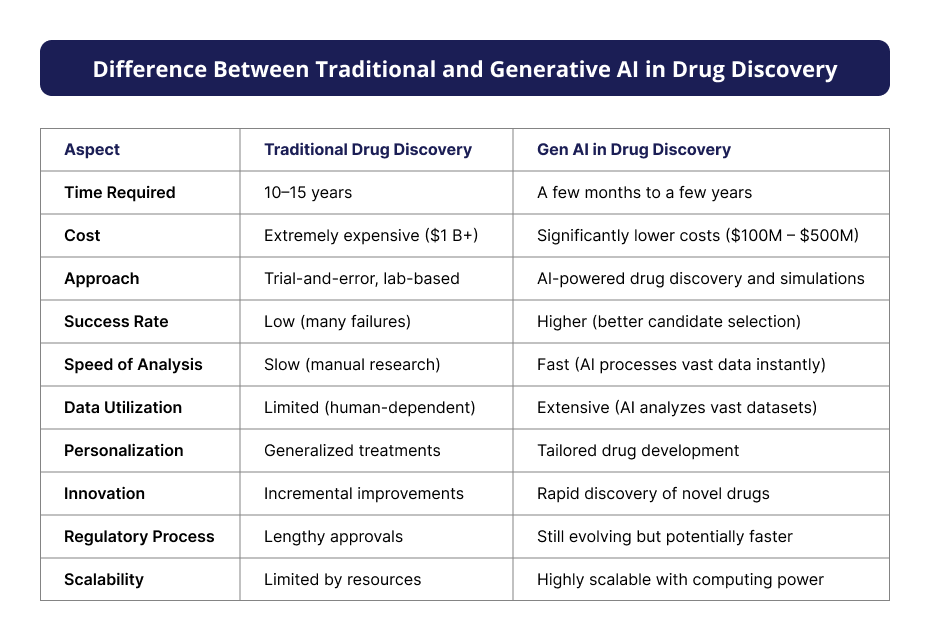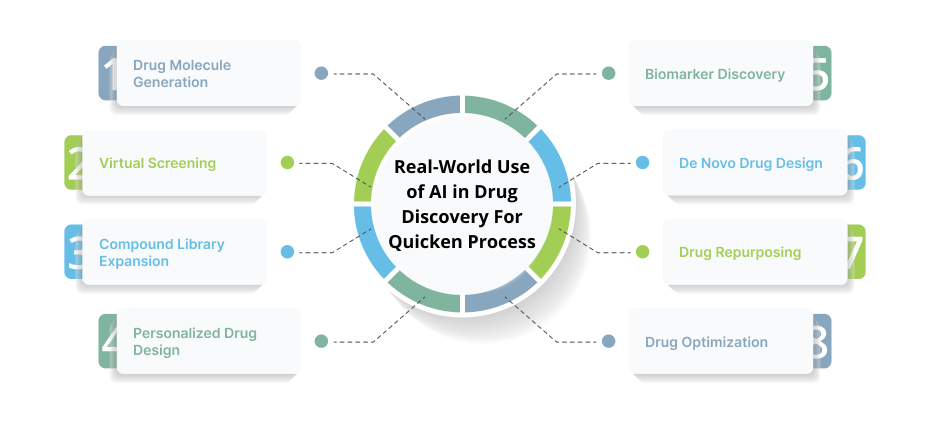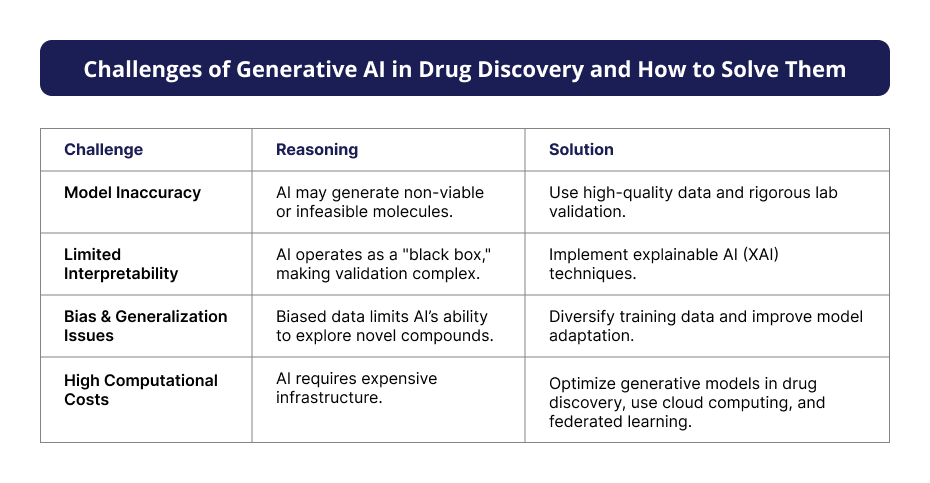Human biology is incredibly complex and intricate, and experts often require deep analysis and expert interpretation to understand diseases and develop effective treatments. The process of discovering disease-focused drugs, being sophisticated, demands time and resources. With the introduction of biotechnology, a progressive path was chosen. The succession of gen AI in biotechnology is transitioning as a transformed workflow in the field of medicine.
Drug discovery is undergoing a revolution. Generative AI is reshaping how pharma companies identify, design, and test new drugs, making development faster and more accurate. To bring an understanding, it is reflected that AI in drug discovery market value reached 1.5 Bn in 2023 and will be increasing with a CAGR of 29.7% till 2030. Confining years of R&D into a few weeks for new compound generation, drug repurposing, and expanding compound libraries has resulted from integrating intelligent technologies.
When such changes occur in the industry, businesses opt for a contemplative partner like consulting leaders. For instance, AI consulting supports drug discovery by combining data from bioresearch centers and R&D labs. This leads to more accurate medication development for targeted diseases. If you’re a decision-maker or biotechnology leader, understanding how Generative AI transforms drug discovery is a competitive advantage. Since such is the premise, it is time to apprehend generative artificial intelligence in drug discovery with a bifurcated guide.
What is Generative AI in drug Discovery?
Generative AI is a modern technology that is being used to work on large datasets. With these datasets in place to analyze and assess, the intelligent model recognizes patterns, combines them, and predicts the possibilities worth experimentation.
To bring this in the case of drug discovery, the Gen AI has proven to be an investment worthy of saving time. The generative AI in drug discovery has been trained on a vast dataset in context to the compounds, existing drugs, their molecular reaction, and their forecasted combination, leading to new drug development. It refers to the use of AI models, like GANs, transformers, and diffusion models, to generate novel compounds, optimize molecules, and streamline the R&D cycle.
This way, the anticipation, clinical trials, and prospective side effects are eliminated in the field of medicine.
Traditional Drug Discovery Vs. Generative AI in Drug Discovery
The traditional drug discovery approach relies on trial-and-error methods, high-throughput screening, and years of lab testing, making it time-consuming and costly. In contrast, Gen AI in drug discovery accelerates the process by analyzing vast datasets, predicting molecular interactions, and optimizing drug candidates, reducing both time and expenses.
The Gen AI in drug development introduced the concept of efficiency, overcame data limitations, and eliminated drug resistance. Such an approach does make the comparison between the outdated and new models an imperative discussion for upcoming decision-makers.
For you to apprehend the possible restructuring in the system, here we bring the comparison.

This comparison highlights the many factors that make AI-driven drug discovery a powerful force for modernization in healthcare and life sciences. For instance, Exscientia, a pioneering AI-driven pharma company, successfully developed a drug candidate for obsessive-compulsive disorder (OCD) using generative AI. Traditionally, identifying and optimizing a compound for clinical trials can take over 4-5 years. With GenAI, Exscientia designed and advanced a novel molecule to clinical trials in just 12 months, a once-unthinkable milestone.
This rapid transition underscores how generative models can drastically shorten R&D cycles by simulating molecular behavior, predicting efficacy, and reducing dependence on physical testing. It’s a clear testament to how AI is transforming traditional pharmaceutical timelines into agile, data-driven innovation pathways.
What are the Popular Techniques of Generative AI in Drug Discovery?
We have understood the distinctive difference between traditional and AI-powered drug development. This does bring us to the working of such cognitive technology. Popular Generative AI techniques in drug discovery include generative models, deep learning, and reinforcement learning, laying the foundation for intelligent AI agents that can autonomously drive decision-making across the R&D pipeline. Highlighting the question, you must be contemplating the Generative AI techniques that are being used in drug discovery. To make a better decision, let us enable you to interpret the techniques used by Generative artificial intelligence in pharma.
1. Transformer Models
Transformers are deep learning architectures that use self-attention mechanisms to process large-scale biological and chemical data efficiently. They excel at understanding complex molecular representations, protein structures, and drug interactions.
How They Work in Drug Discovery?
- Protein Structure Prediction: Transformers like AlphaFold predict 3D protein structures, helping identify potential drug targets.
- Molecular Representation Learning: Models like ChemBERTa and MolBERT learn molecular embeddings from SMILES notation, aiding in property prediction and molecular generation.
- Drug-Target Interaction (DTI) Prediction: Transformers analyze vast datasets of protein-ligand interactions to suggest potential drug candidates.
2. Diffusion Models
Diffusion models generate molecular structures by iteratively refining random noise into meaningful chemical representations. Inspired by physics-based diffusion processes, they create high-quality molecules while maintaining the desired properties.
How They Work in Drug Discovery?
- Molecular Generation: Diffusion models like PocketDiffusion generate drug-like molecules with optimized properties.
- Ligand-Protein Docking: DiffDock enhances drug binding prediction by simulating how molecules fit into protein binding sites.
- De Novo Drug Design: These models help create novel compounds with optimized pharmacological properties.
3. Recurrent Neural Networks (RNNs)
RNNs are machine learning in drug discovery models designed for sequential data processing. In drug discovery, they generate molecular structures by treating chemical representations (e.g., SMILES strings) as sequences of tokens.
How They Work in Drug Discovery?
- De Novo Molecular Design: RNN-based models like DeepSMILES and ReLeaSE generate new molecules by learning from existing chemical databases.
- Molecular Property Prediction: LSTM-based RNNs analyze molecular sequences to predict bioactivity, toxicity, and solubility.
- Optimization of Drug Candidates: Reinforcement learning combined with RNNs fine-tunes generated molecules for better drug-likeness and efficacy.
Adding Value at Each Stage of AI in Drug Development
Since the techniques enabled in comprehending the functional model of computational drug discovery, the time to bring forth stage-focused understanding has been reduced. By building an intelligent system with AI model development, pharmaceutical companies can add value to their drug development during all phases. Contemplating such a foundational change can be seen in the following ways:
1. Target Identification
The first drug discovery and development phase involves the identification of the disease or condition that needs to be treated. Generative artificial intelligence in drug development has the capability to analyze genomic data to interpret the genes causing the disease or other underlying genetically possible biological processes. This way, the GenAI assists in pinpointing the exact targets for new drug development and brings forth a focused solution.
2. Gen AI in Lead Generation
Once your drug discovery model is in place after the artificial intelligence development, the second phase of generating potential drug leads begins. For bringing in the chemicals or proteins that could cure the pinpointed disease, the Generative AI can recognize the apt compounds through these possibilities with the preferred disease-curing properties, creating innumerable leads to examine.
3. Optimization
In the third phase of AI for drug discovery, the potential drug prospects ought to be experimented on for effectiveness. Generative AI can assist in this large-scale dataset screening process.
4. Preclinical Validation & Toxicity Prediction
Before lab or animal testing, AI can simulate biological responses to drug candidates. It evaluates toxicity risks, off-target effects, and overall safety using in silico models. This early validation helps eliminate weak or dangerous compounds from the pipeline, saving time, cost, and ethical concerns in preclinical trials.
5. Biomarker Discovery
AI plays a key role in identifying biomarkers, biological indicators that signal how a patient is responding to a drug or the progression of a disease. These markers are critical for developing targeted therapies and monitoring clinical trial outcomes more accurately, especially in oncology and precision medicine.
6. AI in Clinical Trial Design & Patient Stratification
AI optimizes trial design by analyzing historical data to recommend ideal protocols, endpoints, and timelines. It can stratify patients based on genetic profiles, lifestyle data, or disease progression to ensure higher success rates. Adaptive trial models powered by AI allow real-time modifications based on interim results, reducing delays and dropouts.
7. Manufacturing Optimization
Although still an emerging area, AI is increasingly used to optimize drug formulation and manufacturing processes. It can predict the best formulation conditions, monitor quality control, and reduce production inconsistencies, leading to faster and more cost-efficient scale-up.
8. Post-Market Surveillance & Real-World Evidence (RWE)
After regulatory approval, AI continues to add value by monitoring real-world performance. It mines data from electronic health records (EHRs), wearables, patient feedback, and public sources to detect adverse events, assess long-term safety, and support label extensions or regulatory decisions.
Real-World Use of AI in Drug Discovery For Quicken Process
As the stage-based understanding has instilled in us, towards the reasoning. Here we go with the advantages that AI and machine learning in clinical trials.

1. AI for Drug Molecule Generation
To begin with, the use of AI can be stated with its primary use. The acceleration in drug molecule generation introduces researchers to the smooth development of novel compounds. Without the assistance of AI, drug discovery was a slow process, with long hours spent on manual labor. Such use has resulted in the production of new chemical structures to bring the world closer to safety.
2. Virtual Screening
The inclusion of Generative artificial intelligence in drug discovery and development enhances virtual screening. With this cognitive technology, the computational devices evaluate millions of substances to verify with the datasets of them being a potential medication. This way, an acceleration is witnessed, and time is saved.
3. Compound Library Expansion
Another use of generative AI in life sciences and drug discoveries is the potential of extending the existing compound libraries. The intelligent model can tweak the existing research and bring forth new compounds and treatments effective for curing a disease.
4. AI in Personalized Drug Design and Treatment
Using Generative AI is becoming an ideal option for bringing in custom medicines for patients with specific diseases. This way, the medical departments can study the person’s genetic information and ensure that the drug development process matches the needs of the individual for personalized results and reduced side effects.
5. Biomarker Discovery
The role of generative AI in drug discovery comes to a groundbreaking point with the identification of biomarkers. AI has proved useful in discovering new biomarkers or indicating the underlying diseases present in an individual’s body. This way, the early-stage elimination can be conducted, leading to a healthy life.
6. De Novo Drug Design
Generative AI has the potential to revolutionize drug discovery by designing novel medications from the ground up, unconstrained by existing molecular structures. This approach opens new possibilities for developing therapeutic compounds uniquely tailored to specific medical conditions, moving beyond the limitations of traditional drug design.
7. Drug Repurposing
With drug repurposing, experts can discover new applications for existing medicines to save time. This way, the disease can be cured better with new compositions ready for the market.
8. Drug Optimization
The use of Generative AI in precision medicine also brings us to the optimization of drugs. Since there are plenty of drugs available in the pharmaceutical industry, they have more things in common than differences. Those are side effects that can be restructured and eliminated from the compound with better use of AI.
Benefits of Generative AI for Drug Discovery
It is not difficult to contemplate the benefits of using AI in drug discovery insights. You can incorporate these benefits with the assistance of an AI transformation services provider who understands the advantages. However, we are presenting you with the reasons that prove advantageous to drug discovery and development-focused R&D experts.
-
Accelerated Drug Development
Bringing in Gen AI in drug manufacturing has enabled the R&D centers and practitioners to speed up the drug development process. With time reduction, it is evident that the general masses and patients are presented with a cure for a recent outbreak just in time.
-
Cost-Efficient Method
While the drug discovery, clinical trials, and development process have been taking up long times, the preceding costs in sustaining that research have amounted to millions and billions. However, with the introduction of Gen AI in clinical trials and drug development, the costs have come down as AI enables results in a shorter time, saving money.
-
Focused on Accuracy and Precision
As the Gen AI models work on large datasets, such a premise brings us to understand that these models bring in accuracy with data-analyzing capability. Since that is the case, it is important to understand that the results presented by the generative AI for biotech are accurate and precise, turning out beneficial for the researcher.
-
Personalized Medicines and Treatment Options
As we have mentioned above, generative AI in pharmaceutical data analysis has the capability to bring forth personalized medicines and treatments based on genetic analysis. This way, the patient can get treatment that works for them and eliminates the reason for side effects.
-
Risk Mitigation
Now that we understand that side effects are a concern for biotechnology, Minor side effects are still tolerable. However, the risk arising from major experimentation can cause lifetime issues. The drug discovery with AI models mitigates such risk and brings forth compounds that are not so dangerous.
Real-World Examples of Generative AI Drug Discovery
To understand the lengths of changes that generative AI in pharmaceutical industry has welcomed, we must apprehend how real-world practitioners brought change. These changes are incorporated with the assistance of an AI and machine learning development company. Since these examples are essential to comprehend the future, here we bring forth examples that can assist you
| Leader | AI Approach Used | Drug Discovery Application | Outcome |
| Exscientia | Generative AI, Reinforcement Learning | Designed the first AI-created drug molecule (DSP-1181) for OCD | Entered clinical trials in record time |
| Insilico Medicine | GANs, VAEs | Developed a fibrosis drug candidate in under 18 months | Successfully moved to preclinical testing |
| Atomwise | Deep Learning in Drug Discovery, Structure-Based Drug Design | Screened billions of molecules for potential COVID-19 and Ebola treatments | Identified promising lead compounds |
| BenevolentAI | NLP, Knowledge Graphs | Repurposed baricitinib for COVID-19 treatment using AI-driven insights | Approved for emergency use authorization |
| DeepMind (AlphaFold) | Protein Structure Prediction | Predicted 3D structures of nearly all known proteins | Accelerated drug target identification |
What are the Challenges of Generative AI in Drug Discovery?
We know that generative AI for pharmaceuticals has showcased wonders to the R&D departments and research centers. However, intelligent technology also has some challenges that need to be addressed just in time for result-based functioning. Since we know you might come across challenges, it is better to have solutions as well.

Future of Generative AI in Drug Discovery
So far, we have estimated the uplifting with generative AI for small molecule discovery, compound repurposing, and expanding libraries. That being said, it directs the lights towards a future that is modernized and fast in bolstering the pharmaceutical industry. Such restructuring also opens the window for the possibility of modifying the sector with data intelligence services.
Since the R&D centers and researchers are instilling intelligent technologies, the generative AI in pharmaceutical innovations will be focused on finding a cure much faster than possible. The possibility of diminishing diseases, outbreaks, and global pandemics is ahead.
How SparxIT Assists Businesses Implement AI in Drug Development
As we understand the rising need for cognitive technologies, modernization requires experience from a generative AI development services provider. SparxIT is a digital transformation expert that focuses extensively on generative AI to bring about the anticipated change.
With over 150+ experts in AI and machine learning in drug development, we enable the change with our industry-focused insights. Not only that, but our understanding of transformational technologies has enabled us to bring a much-needed change to our clients. That being said, if you, as a decision-maker, want to modify the drug discovery and development practices in your organization, contact our AI professionals.

Partner with Experts
Frequently Asked Questions
What is Generative AI in drug discovery?









Generative AI in drug discovery uses advanced AI models to design new drug molecules, predict their behavior, and speed up research by simulating trial outcomes.
What is the role of Generative AI in drug discovery?
















It helps identify novel compounds, optimize drug properties, and shorten the development cycle by automating and accelerating key research stages.
What are the key benefits of using Generative AI in drug development?
















It reduces R&D time and cost, improves accuracy in molecule prediction, supports personalized medicine, and increases the success rate of drug candidates.
Which pharmaceutical companies are using Generative AI for drug discovery?
















Companies like Insilico Medicine, Pfizer, Amgen, Novartis, and BenevolentAI are actively using Generative AI to accelerate drug discovery and development.
How are pharmaceutical companies using AI for drug discovery?
















R&D and pharmaceutical companies are using generative AI for computational drug development to reduce the time and bring cost-efficient solutions.
What machine learning models are used in AI-driven drug discovery?
















Machine learning models like transformer models, diffusion models, recurrent neural networks (RNNs), AI and big data in drug research are being used currently.
What are the challenges of implementing AI in drug discovery?
















Among the many challenges, model inaccuracy, bias and limitation generalization, limited model interoperability, and infrastructure limitation are the ones that you must take into consideration.



